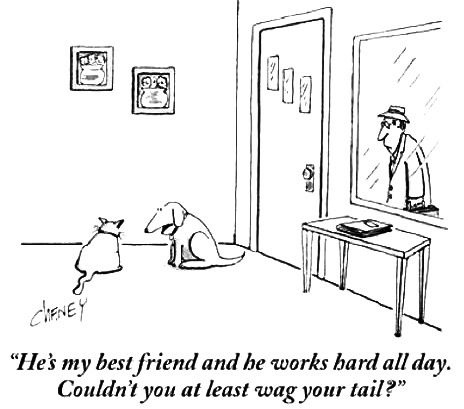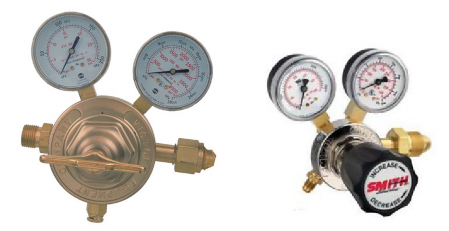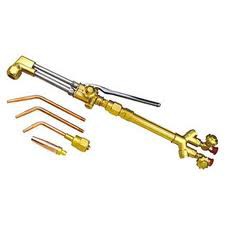How To Get The Most Out Of Your Used Equipment:

A chap sees an advert in a pet shop window for a talking centipede, priced at
$1000. Thinking he’s found a bargain, he buys it and takes it home in a box. After about 30 minutes, he opens the box and politely asks if the centipede would like to go down the pub for a pint, but the centipede doesn’t answer. A couple of minutes later, he asks again, but still no response. He starts to get a bit upset, and thinking he’s been done he shouts the question again, at which the centipede pops his head out of the box and says, “I heard you the first time you twat, I’m putting my shoes on!”
From time to time, people bring in their newly acquired used oxy-acetylene welding equipment. They’ve usually acquired it in one of two ways. One, it’s come through inheritance. Uncle Joseph is no longer amongst us but his tools are. So Aunty is quickly passing on the equipment to the nephew, whose face always glowed when entering a hardware store. We aren’t the Antiques Roadshow but sometimes are asked to perform it. We examine the equipment and realize Uncle Joseph never used this stuff – none of the equipment matches, or an essential piece is missing. And if the missing piece(s) were to be found, it would cost more than all the tools are worth. The second method is someone went to the auction (or yard sale, or internet, etc.) and fell under the spell of the auctioneer’s chant. They are now looking for some redemption: surely spending this amount of money can only mean I acquired something of value. They did acquire something and it’s called an education. This education is taught at flea markets, auctions, yard sales and on-line; tuition can be comfortably low or embarrassingly high. The course has many names (spouses call it all sorts of things; most guys know what it is after the first sentence of the story) but it’s basically Buying 101: what you need to know before you go. Its aim is to help guys not to depend on their “winging it” instinct.
Here are some tips on Used Oxygen-Acetylene Welding Equipment
-
- 1. Find out how much new equipment is worth. New equipment means you can return it. It has very little risk involved. Used equipment at an auction, the Internet etc. has a high risk factor; all sales are final. Therefore discount the equipment to cover your risk. If they don’t let you test it – take a bigger discount.
-
- 2. Manufacturers’ equipment only works with their stuff – it’s not interchangeable. There are no exceptions or magic tricks available.

-
- 3. The war for the most popular Oxy-Acetylene equipment in North America is over (the New York Times doesn’t report everything). Victor is the most popular brand. In Canada, Liquid Air is very popular, too. So, if you possess Victor equipment, especially their heavy duty line, then obtaining accessories or parts is going to be easy. Anyone who claims to sell welding supplies, even if they also sell cat food, diapers, and cork boots, will have some Victor stuff on their shelf. What about the other manufacturers? They have good stuff too but lost the popularity war. So if you want to add welding tips or cutting tips, then be patient and hope for some good luck. You’re going to have to identify your equipment (the manufacturer’s name), find out what series (usually the manufacturer has several lines of equipment for various type of users), who sells it, and how to order it. Going to your local welding store doesn’t always work – they may not recognize the equipment or might not want to participate in your Easter Egg hunt (especially if there’s nothing in it for them).

-
- 4. Regulators have a lot more wriggle room. Regulators don’t need to match the welding equipment. The torch and tips work wonderfully well with whatever regulator is attached to the cylinder; a Harris oxygen regulator and Purox acetylene regulator won’t cause any problems. So if the regulator is the bad apple in the barrel then go get a new one. Good news: the prices have dramatically dropped for regulators. Generally, regulators live a sheltered and exalted life. It’s their easy lifestyle that’ll make you think they’re in great shape. So before you get too excited, check the brass fittings. Those fittings are made of soft material and get easily damaged. They are susceptible to dust and damage to the inside filter. If you’re hesitant, replace them. It’s easy putting new ones on if you know what you’re doing. But the biggest challenge might be in finding replacements. Not all welding suppliers will have them. Plus a few regulators have a different thread size on their body.

-
- 5. Torches, two things have to be decided. One, are you going to Cut or Weld and Cut. All torches can cut but to weld you need a 2 piece torch (see above). If welding is what you want to do, make sure you have a really really good reason to. Not many welding tips are stocked anymore; the simplicity and superiority of MIG welding has replaced brazing. But if you’re still insistent on brazing, remember your welding supplier many not carry any welding tips (even the most popular ones); they are expensive ($50 or more), have to be ordered in and paid for in full – no one wants them on their shelves. Second thing to decide is what fuel gases are going to be used with your torches: acetylene, propane or natural gas? The answer to that question will tell you what kind of tip is needed; each fuel gas requires a different tip. But some Harris cutting torches, in addition to proper cutting tips, require an injector to match the fuel gas; if the injector needs to be changed, it can be done with patience and money.
-
- 6. Welding hoses can be a problem. Lying around for ages, the wrong fuel gases running through them, cuts, squished fittings can make them a suitable candidate for the old heave-ho. If they need to be replaced, remember R Grade is for acetylene gas and T is for other fuel gases. If you don’t like remembering useless information – T grade works for all fuel gases. Another problem, nice thing is it’s not common, are the fittings on the torch don’t match the fittings on the hose. Smaller welding handles can sometimes have smaller hose fittings (called A fittings) while your regulator has B fittings. This requires the hose to have 2 different fittings – not a common thing. There are 2 solutions; both require you not to be in a hurry. Purchase a twin welding hose with the 2 different ends. Or buy adaptors for the torch to take the standard B fittings.
We do sell used welding equipment but it’s well made equipment, it’s not cheap, and never very much of it. We can repair and test most welding equipment. We do try and make Uncle Joseph look like a good guy.
Cheers,
Ron-Son’s Torch



